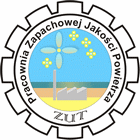Przegląd www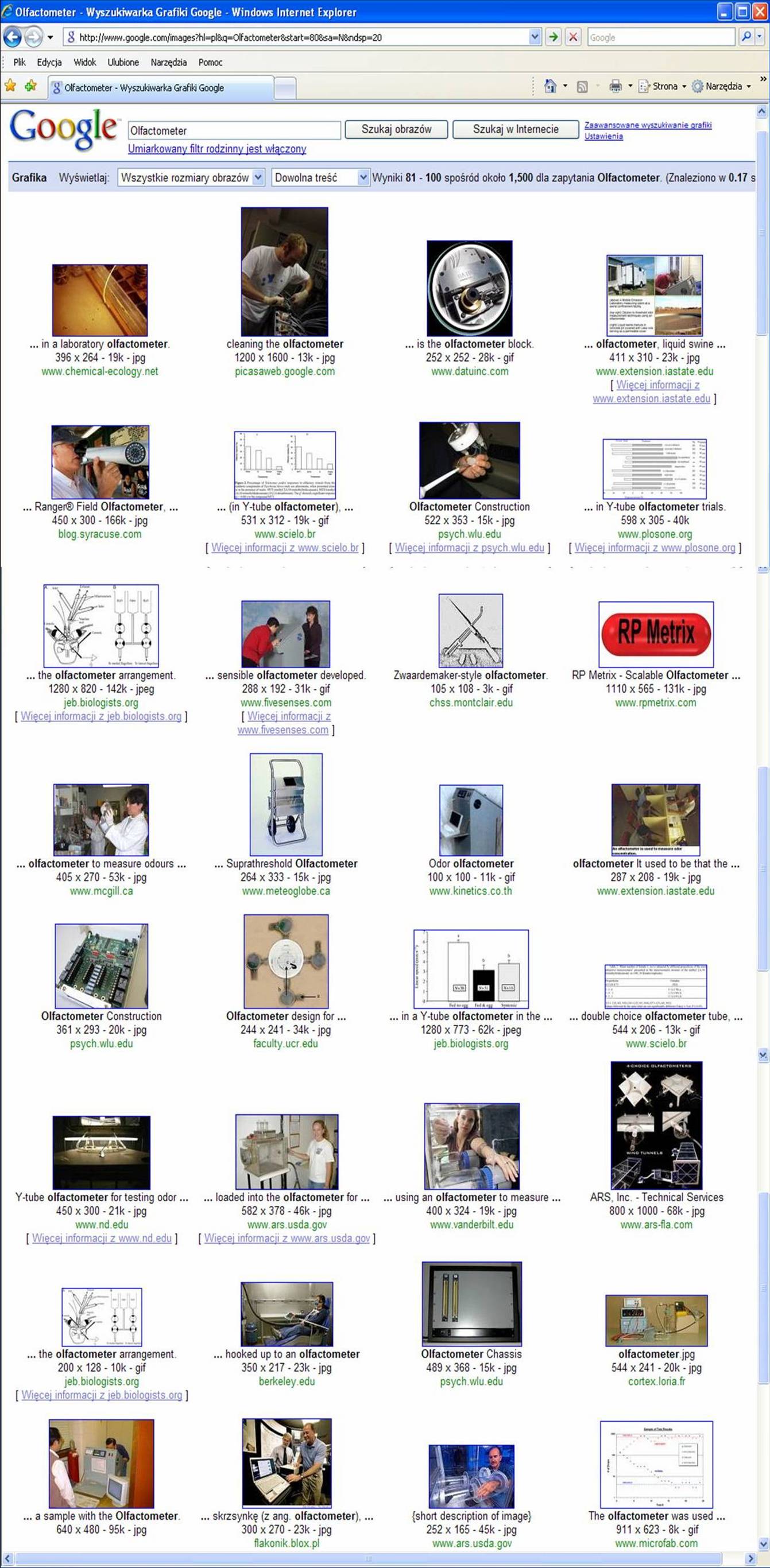
z Wikipedii:
Olfaktometr to przyrząd służący do badania czułości narządów węchu, bądź też przyrząd do ilościowych porównań intensywności zapachów różnych olejków eterycznych w unormowanych jednostkach pomiarowych.
Inne rodzaje olfaktometrów, to urządzenia stosowane w czasie pomiarów stężenia zapachowego zanieczyszczeń w gazach emitowanych do powietrza lub w zanieczyszczonym powietrzu. W Europie pomiary olfaktometryczne są wykonywane zgodnie z normą EN 13725:2003, w której określono wymagania stawiane olfaktometrom dynamicznym - urządzeniom do rozcieńczania strumienia gazu zanieczyszczonego strumieniem czystego powietrza. Zapach mieszaniny ocenia odpowiednio dobrany zespół ludzi.
Olfaktometrami nazywane są również rozmaite urządzenia, umożliwiające badania węchu owadów, w tym opracowywanie chemicznego składu kompozycji odstraszających lub przynęt.
Przegląd ilustracji w Google - kliknij na obrazku po prawej.
Poniżej - przykłady olfaktometrów badawczych
oraz przegląd komercyjnych urządzeń,
stosowanych przez służby ochrony środowiska. |
Olfaktometry muzealne |
 |
Przykład konstrukcji olfaktometru Univ. W&L
do badań psychologiczno-elektrofizjologicznych
|
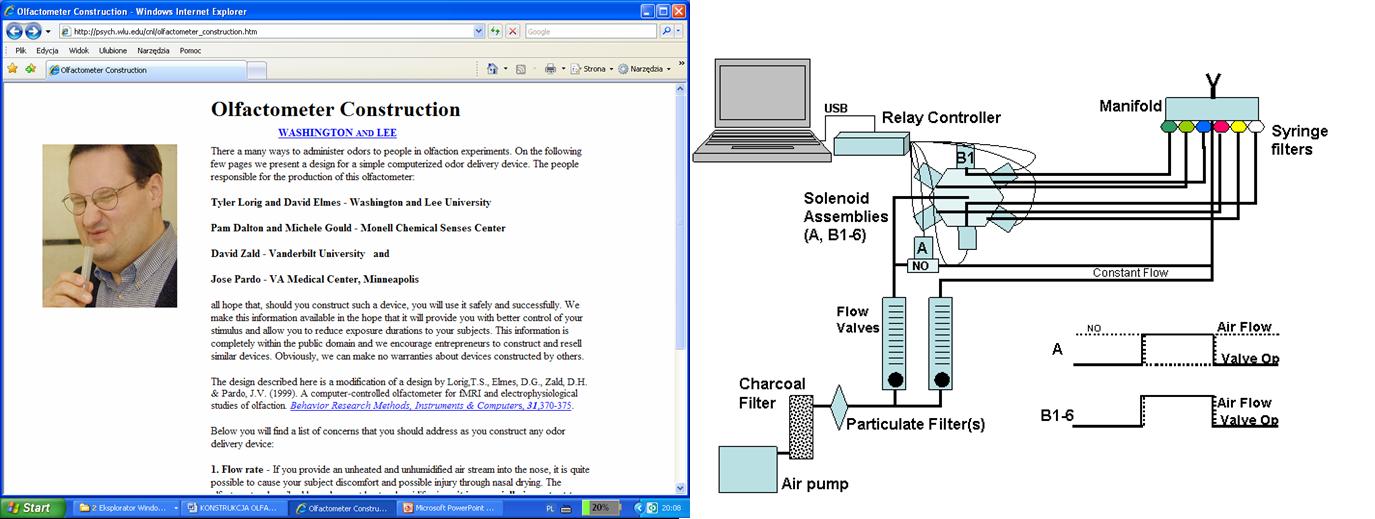 |
|
OLFAKTOMETRY W OCHRONIE ŚRODOWISKA
|
ODOURNETNow in its third generation, the Olfaktomat-n represents the cutting edge olfactometer for presenting odour samples for olfactometry analysis. The Olfaktomat-n is a fully computer controlled instrument that provides repeatable dilutions over a wide range (12 – 100,000) with a high level of accuracy. Combined with the WiNose software the Olfaktomat-n is a turnkey solution to reproducible odour measurement. It is available in a basic model that allows one assessor to work (olfaktomat-n1) and can be supplied or upgraded to a two-assessor (n2) or six assessor (n6) model. Olfaktomat olfactometers are routinely used in close to 20 laboratories around the world. The equipment and methodology complies with stringent national and international standards, such as the Dutch standard NVN2820 ‘Olfactometry’ and CEN 13725: 2003.
Download product sheet
|
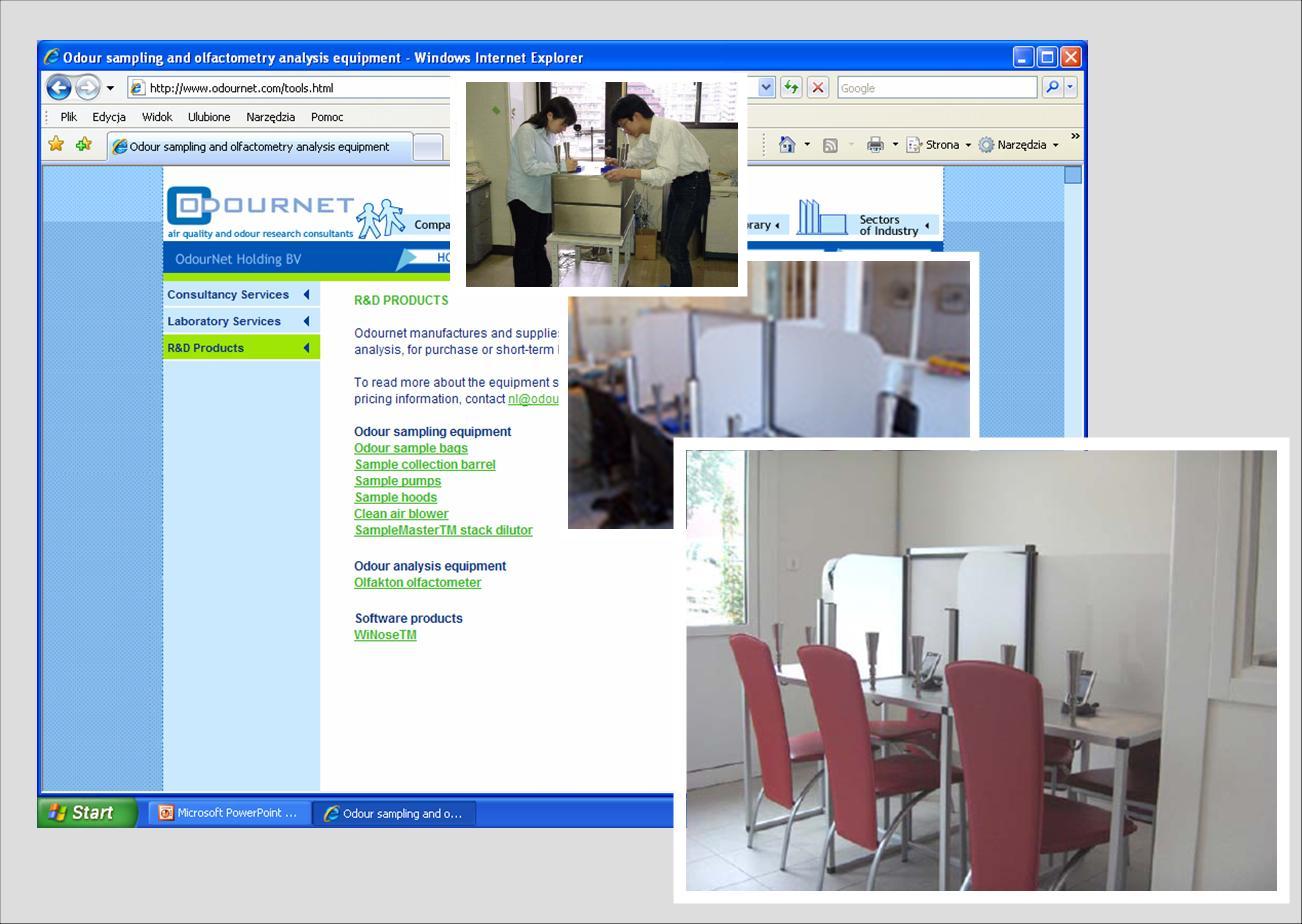
|
ECOMA
Das Olfaktometer TO 8 erfüllt die Voraussetzungen als Verdünnungseinrichtung zur olfaktometrischen Messung nach DIN EN 13725:2003 (D) und versetzt Sie in die Lage, auf dem Weg der dynamischen Olfaktometrie eine Geruchsprobe vollständig zu beschreiben.So ermöglicht das TO 8 neben der Bestimmung der Geruchsstoffkonzentrationdie Bestimmung der Geruchsintensität und der hedonischen Wirkung. Das Olfaktometer TO 8 verfügt über ein vollautomatisches Verdünnungssystem mit einem Verdünnungsbereich von 22 bis 216 ; in Allen Verdünnungsstufen liegt ein konstanter Volumenstrom an. Dokumenten Download
|
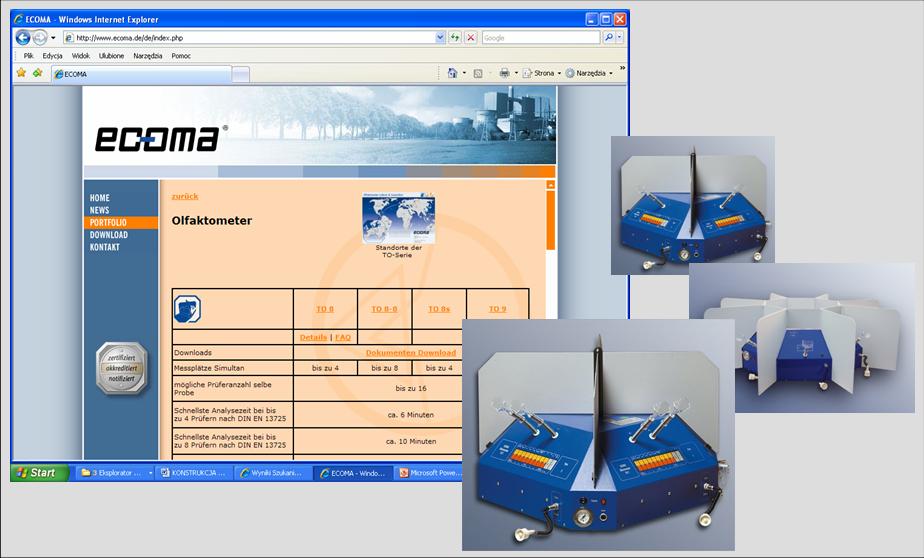
|
Z www Queensland Gov.:
The intensive livestock environmental management air quality laboratory consists of a Forced-Choice Dynamic Olfactometer, designed and operated to meet the requirements of the Australian / New Zealand Standard - Stationary Source Emissions - Determination of odour concentration by dynamic olfactometry (AS/NZS 4323.3) The Olfactometer uses a panel of 8 people (assessors) to evaluate 'air' being presented at 3 ports. 2 ports present clean, odour-free air and the third supplies diluted, odorous air. Of the 3 ports - the assessors must select which one contains odorous air. This is referred to as forced-choice as opposed to yes/no olfactometry. The assessors also indicate whether the answer they gave was based on certainty, an inkling or a guess. Only those reponses that are correct and given with certainty are regarded as 'true' for the purposes of data calculation. Dynamic Olfactometry means that we can constantly vary the dilution of the odorous air presented to the assessors.
|
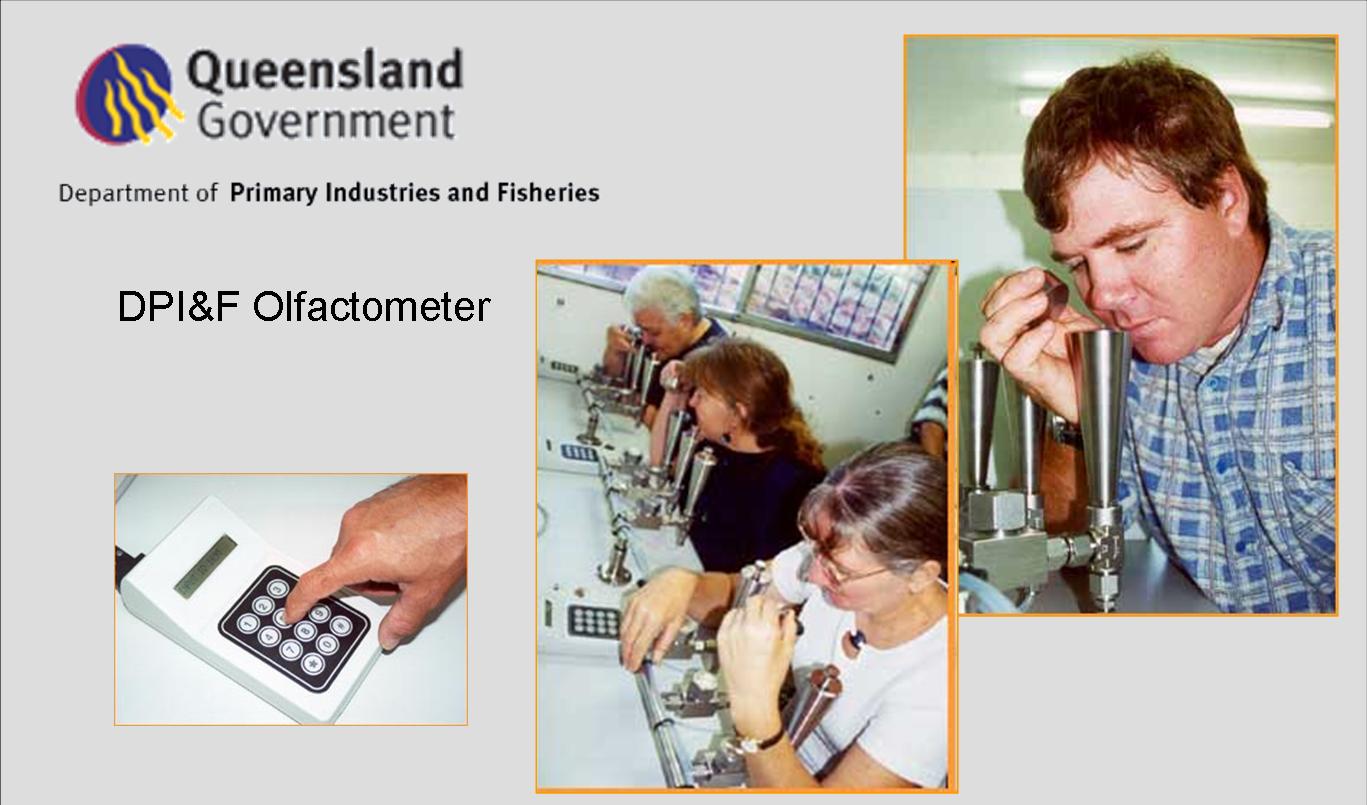
|
| DynaScentIts instrumental performance exceeds the requirements in both Australian and New Zealand AS/NZS 4323.3:2001 standard and the European EN 13725:2003 standard. The DynaScent olfactometer has made significant improvements to the performance of the dynamic olfactometer:
- accurate and repeatable dilution ratios
- automated instrument calibration
- cleaning procedure to reduce the cross contamination
- data management system
- extend the odour measurement to the odour intensity and ambient odour index. To download the DynaScent Brochure, please click here
|
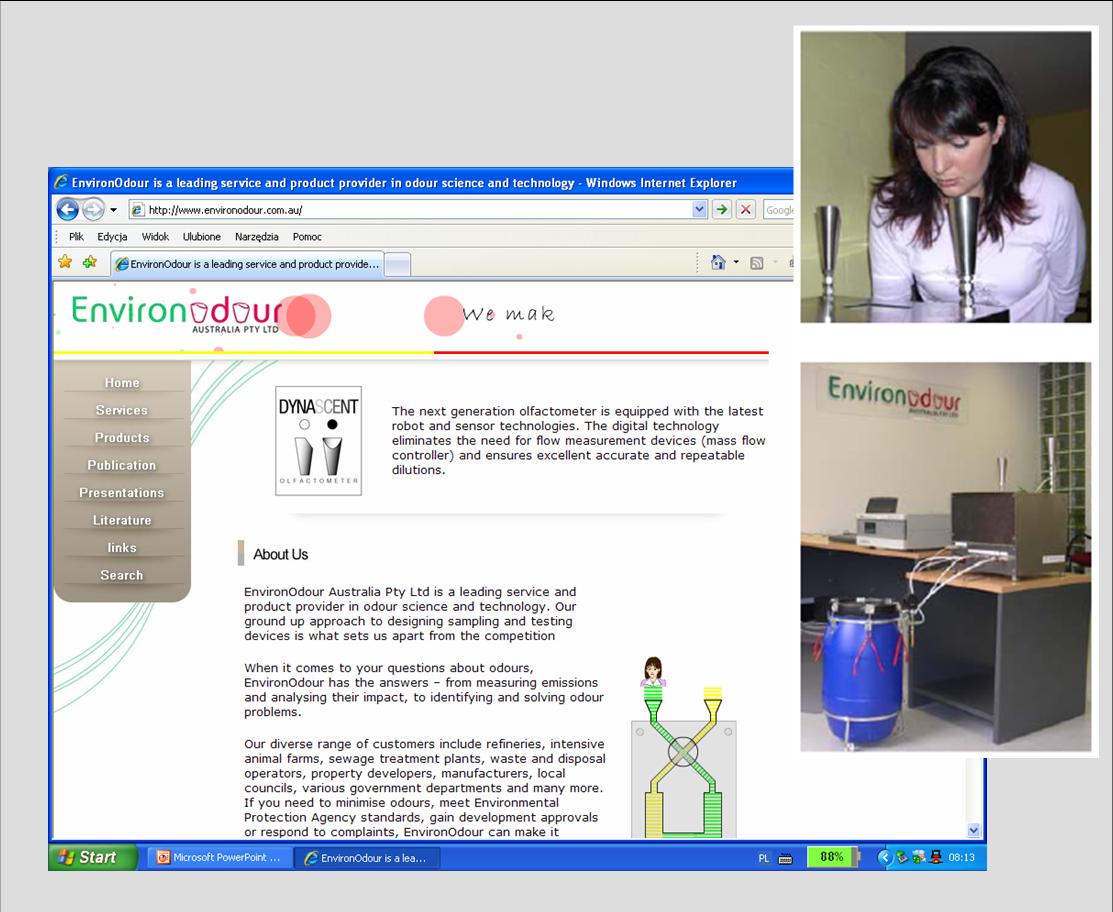
|
DPI&F's Olfactometer
has been constructed to meet the Australian / New Zealand Standard - Stationary Source Emissions - Determination of Odour Concentration by Dynamic Olfactometry (AS/NZ 4323.3). Mode: Forced choice
Number of sniffing ports: 3
Panel size: 8
Presentation flow: 20 lpm
Presentation order: Ascending
Maximum (lower) dilution ratio: 2
Minimum (upper) dilution ratio: 215
|
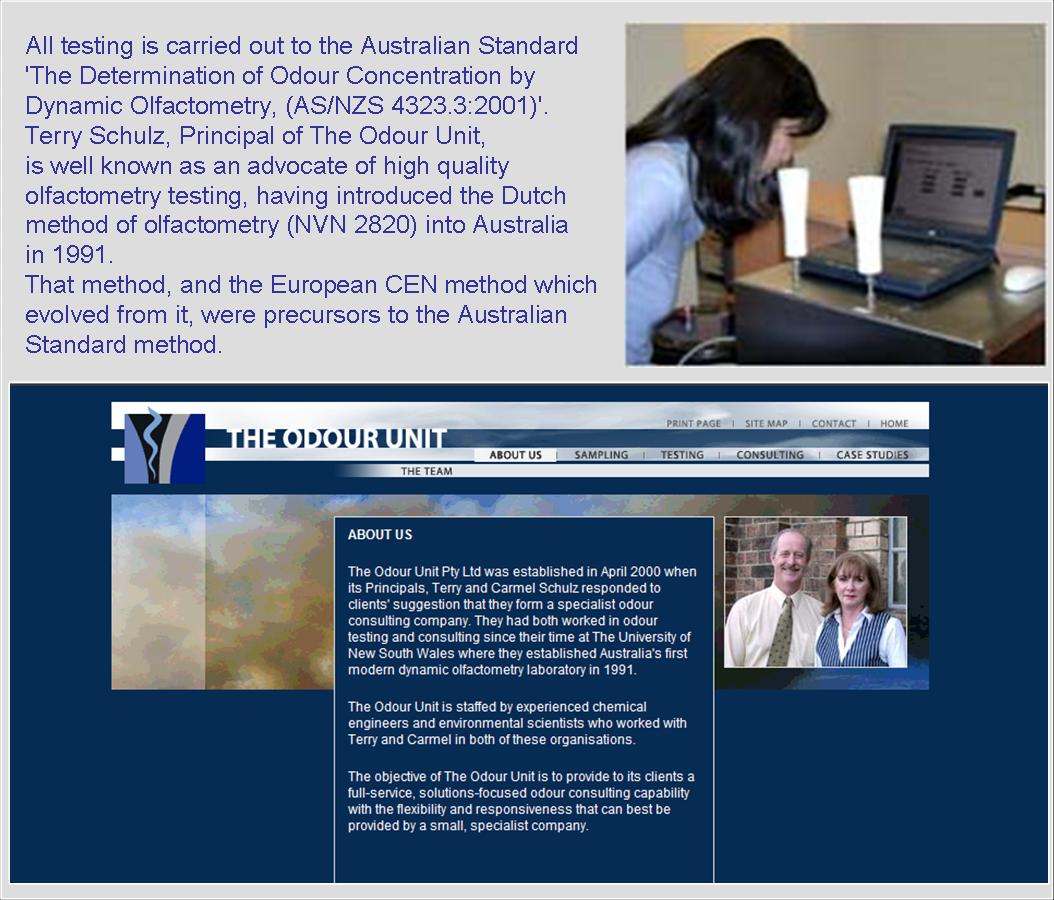 |
| Forced-Choice Method: The "Forced-Choice" presentation method, as described by ASTM E679-91, is called the "3-alternative forced choice presentation" method or the "triangular forced-choice" method. Each panelist performs the odor evaluation task by sniffing the diluted odor from the olfactometer. The panelist sniffs three sample presentations, one of which contains the odor while the other two are "blanks." The panelist must then select the one of the three that is "different" from the other two. This statistical approach is called "triangular forced-choice." The panelist is required to declare to the panel leader, either verbally or by pushing a button, if the selection is a "guess", "detection" , or "recognition", as defined by ASTM E679-91. Yes / No Method: The Yes/No Method is based on protocols used in audiometry. Each panelist sniffs a sample from the olfactometer. The sample is either a diluted odor or a "blank" of odor free air. ion series." The panelist then declares whether an odor is presented (Yes) or not (No). Six presentations are randomly delivered (three samples and three blanks) to the panelist at each dilution level. Ascending Concentration Series For both test methods, after the first dilution level the panelist is then presented with the next dilution level. In the "Forced-Choice" method the panelist is again presented with three sample choices, one of which is the odor sample. However, in the "Yes/No" method the panelist again tests six randomly presented samples. However, in both cases this next dilution level presents the odor at a higher concentration (e.g. two times higher). The panelist continues to additional higher levels of sample presentation following these methods. This statistical approach of increasing levels of sample presentation is called "ascending concentration”.
|
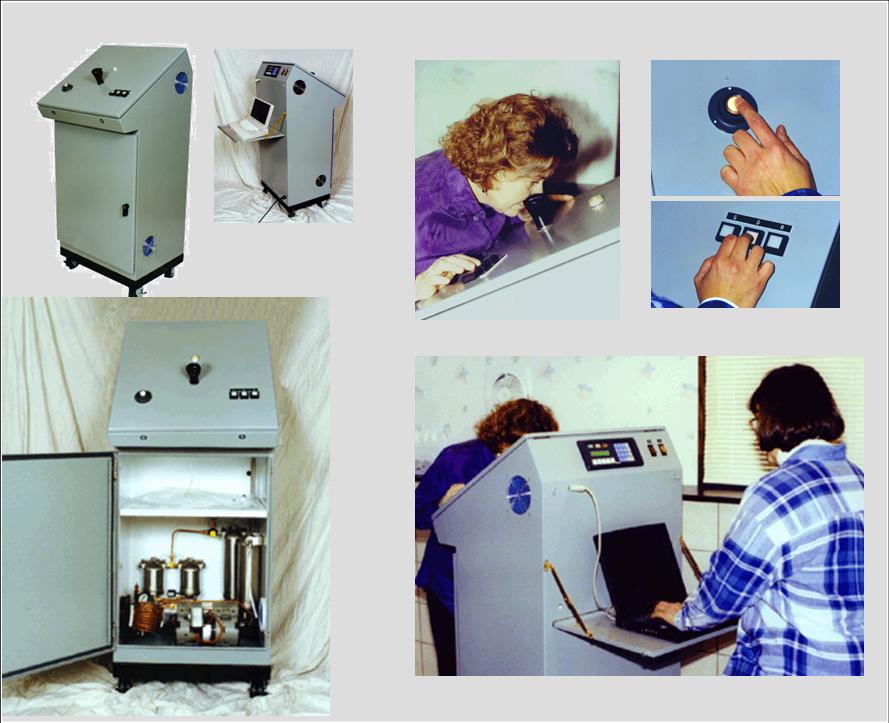
|
| The Importance of Field Olfactometry |
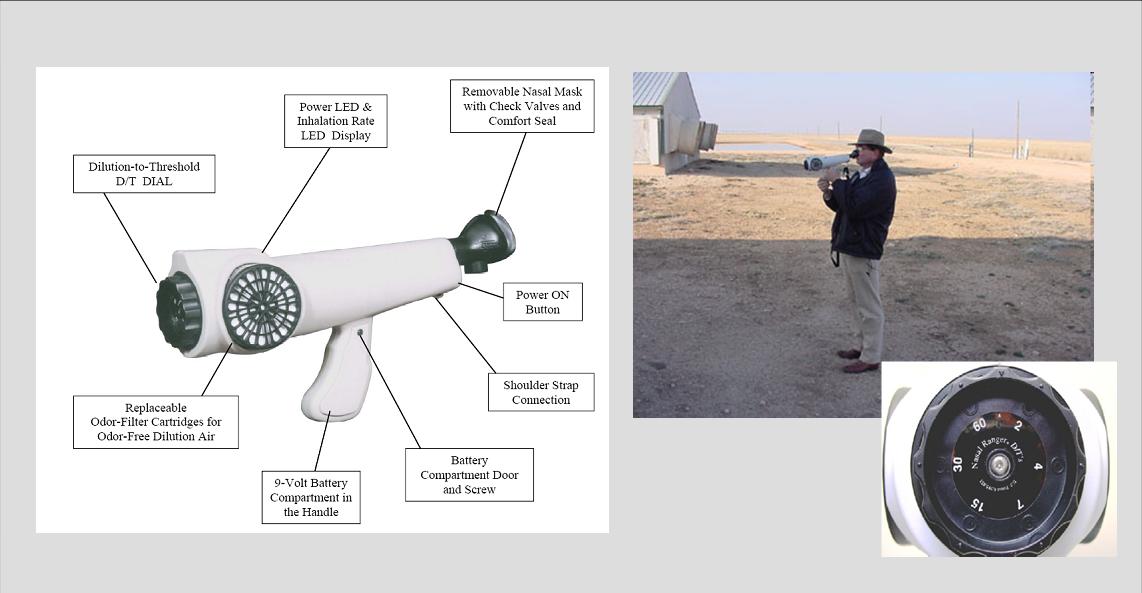 |
ODILE
The dilution unit consists of several mass flow-controllers & a saturator for:
• obtaining a 1 to 2 000 000 dilution range without predilution and unlimited step units between each dilution level;
• generating air flow with n-butanol concentrations within 5 to 75 000 PPB(v);
• furnishing pure air flows to initialize the olfactory epithelium of panel members and proceeding to the triangular evaluation of the perception thresholds;
• purging the system between jury exposures;
• proceeding to a system cleaning after each olfactometric analysis;
• activating the auto-cleaning system for all pipes and electromechanical parts after each day of use.
The olfactometer is designed to prevent contamination between jury exposures and high concentrations before voting. |
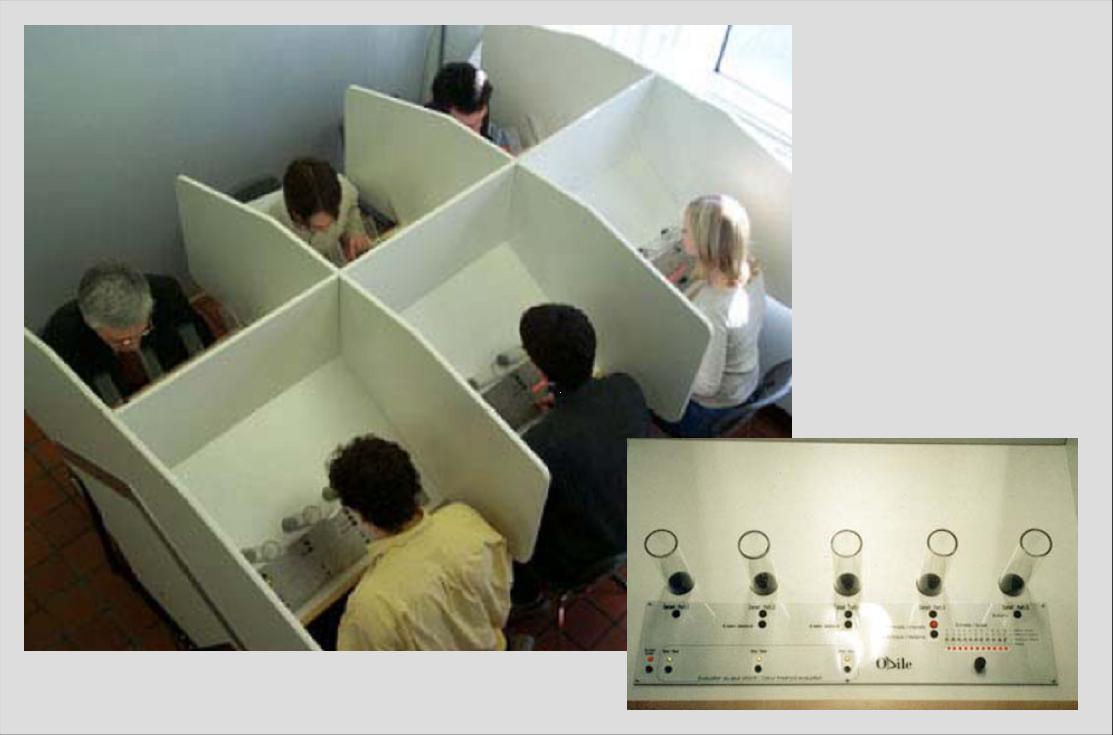
|
The TECNODOR
is a patented suprathreshold dynamic dilution olfactometer which uses a referencing substance. It provides sensory measures of unpleasant odours. The sensory measure calls on humans (the jury) to compare the intensity of an unpleasant odour with that of a neutral reference odour of known concentration in the air. As a function of this reference odour, 1-butanol, the TECNODOR allows the intensity of an odour to be quantified and its profile determined. These data can also be used to determine the persistence and threshold of an odour.
|
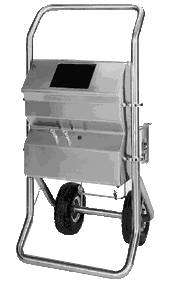 |
OLFAKTOMETRY STOSOWANE W PRACOWNI
W latach 1993-2005 w Pracowni był stosowany jednostanowiskowy olfaktometr dynamiczny Stroehlein (finans. KBN. i WFOŚiGW w Szczecinie). Strumienie czystego powietrza i badanego gazu są w nim wytwarzane przez dwie szklane pompy tłokowe z uszczelnieniami teflonowymi. Prędkość przesuwu tłoków jest automatycznie regulowana w szerokim zakresie, co pozwala zmieniać stopień rozcieńczenia w szerokim zakresie od 1:1 do 1:10000. Zainstalowany w urządzeniu program sterujący umożliwia swobodne ustawianie kroku w serii rozcieńczeń, czasu prezentacji próbki i czasu przerwy itd. Możliwe jest również wybranie opcji ciągłego dozowania – od chwili startu do zatrzymania – próbki rozcieńczonej w wybranym stopniu. Olfaktometr nie spełnia wymagań normy EN 13725:2003. Strumień gazów wypływających z króćca wylotowego (6 dm3/min) jest ponad trzykrotnie mniejszy od wymaganego. Olfaktometr jest obecnie stosowany jako urządzenie do wstępnych dynamicznych rozcieńczeń próbki przed jej analizą z użyciem olfaktometru TO7 oraz do przygotowywania próbek badanych metodą ekstrapolacyjną. |
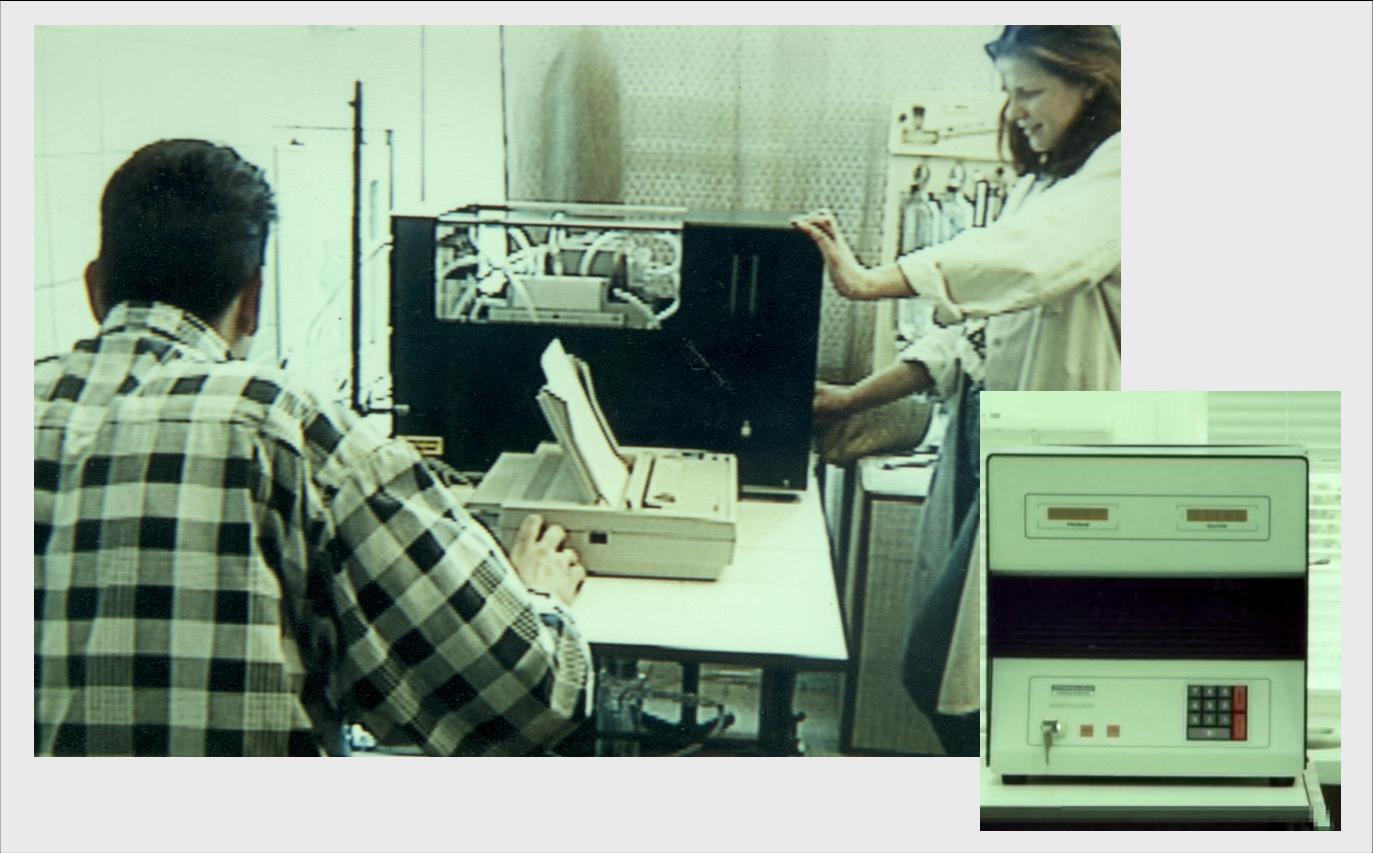
|
Olfaktometr dynamiczny TO7 (ECOMA) jest stosowany w Pracowni od r. 2005. Został nam przekazany przez Wojewódzki Inspektorat Ochrony Środowiska w Łodzi.
Zasada działania - patrz prezentacja ppt z narracją: OLFAKTOMETRIA DYNAMICZNA (format: zip, rozmiar: 29 MB) ( 9 min); w ppt - krótka informacja nt. Nasal Rander..
|
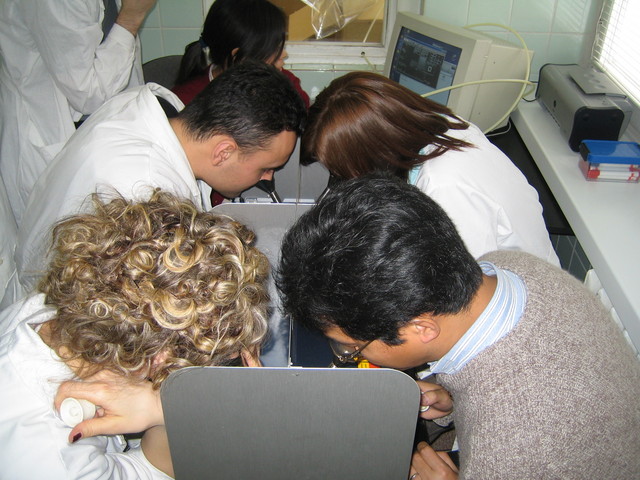 (format: zip, rozmiar: 29 MB) (format: zip, rozmiar: 29 MB) |
Pracownia dysponuje czterema olfaktometrami terenowymi NASAL RANGER. Umożliwia to wykonywanie pomiarów zespołowych. W latach 2006-2008 pomiary wykonywano w otoczeniu ferm hodowlanych (ferma norek, ferma tuczu świń). Potwierdzono poprawność prognoz zapachowej uciążliwości ferm trzody chlewnej , sporządzanych w oparciu o dostępne wskaźniki emisji zapachowej, metodą modelowania dyspersji (model referencyjny).
|
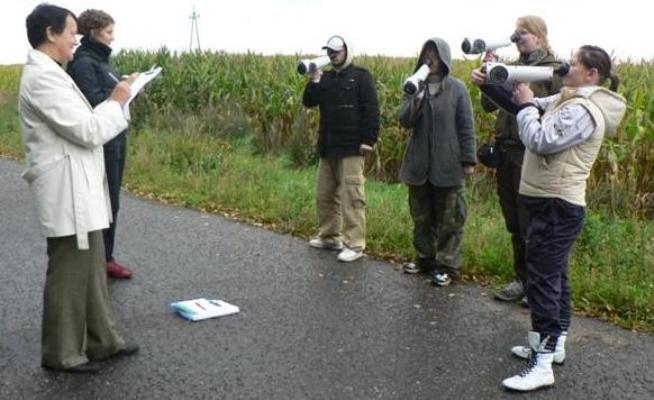
|
|
Publikacje: - Kośmider J.: Zapachowa uciążliwość chowu trzody chlewnej (ppt) (format: ppt, rozmiar: 52 MB); Międzynarodowa Konferencja i Międzynarodowe Warsztaty nt. "Rolnictwo zrównoważone a wielkoprzemysłowa produkcja zwierzęca w kontekście przeciwdziałania eutrofizacji Morza Bałtyckiego", Kołobrzeg 2010; materiały konferncyjne (ISBN 978-83-924762-5-2), str. 47-51, Wyd. Federacja Zielonych GAJA
- Friedrich M., Kośmider J.: Weryfikacja prognozy zapachowej uciążliwości. Przykład fermy trzody chlewnej, Ochrona Powietrza i Problemy Odpadów nr 4, 128-136, 2009 (abstract),
- Kośmider J., Krajewska B.: Measurements of temporary values of odour concentration (pdf ) (Pomiary chwilowych wartości stężenia zapachowego); Polish Journal of Environmental Studies 16 (2), 215-225, 2007
|
|














